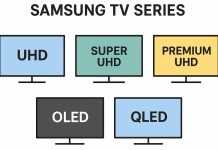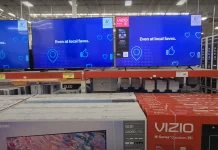Television manufacturers often categorize their products into two main groups: home TVs (Consumer TVs) and commercial TVs. Each is designed with specific features tailored to its intended environment. While home TVs are meant for personal use, commercial TVs are built for use in business environments such as hotels, offices, and public spaces.
Home TVs (Consumer TVs)
Home TVs are designed for everyday consumer use, providing high-quality picture and sound for entertainment purposes. These models are optimized for personal viewing, with features like smart apps, streaming services, and an intuitive user experience. Home TVs are generally user-friendly, focusing on convenience and versatility for things like watching movies, playing games, or enjoying TV shows.
Commercial TVs
Commercial TVs, by contrast, are designed to meet the demands of professional or business settings. These models come with enhanced functionality to support their use in high-traffic areas, such as hotels, shops, exhibition spaces, and conference rooms. While they offer similar features to home TVs, commercial models have added features tailored to meet the specific needs of business environments.
Key Differences Between Home and Commercial TVs
- Security Features:
One of the main differences is the security features in commercial TVs. Commercial models often come equipped with features like the Kensington Lock, providing anti-theft protection. This is essential for TVs installed in public areas where the risk of theft or tampering is higher. - Remote Control Customization:
Commercial TVs allow the remote control to be linked to just one TV, even if there are multiple identical units nearby. This feature is particularly useful in settings like presentations or conferences, where a presenter needs to control one TV without interference from others. - Cloning Settings:
Commercial TVs support the ability to clone settings to multiple units using a USB device. This feature is invaluable for environments like hotels or offices, where it’s necessary to configure multiple TVs with identical settings quickly and efficiently. - Restricted User Settings:
Many commercial TVs offer the ability to restrict changes to settings. This ensures that only authorized personnel can alter settings, maintaining consistency across all units in a hotel, office, or public space. This is particularly useful in environments where the TVs need to stay configured for branding, security, or operational consistency. Commercial TVs also have more sophisticated settings that allow you to turn the TV on and off remotely, such as over IP, to stream content to multiple TVs at the same time. - Warranty and Support: The warranty and support for home and commercial TVs differ significantly:
- Home TVs usually come with a standard warranty, typically lasting between one to two years, covering manufacturing defects and issues from regular use. Support is usually accessible through customer service channels like phone, email, or online chat.
- Commercial TVs, on the other hand, often come with extended warranties that cover high-usage scenarios, longer operating hours, and more frequent use. These warranties are designed to ensure that commercial models maintain their performance over extended periods, reducing the risk of downtime. Additionally, commercial models often offer on-site support, meaning technicians can be dispatched directly to the location to resolve any issues. This is especially important in settings where TV downtime can impact business operations.






